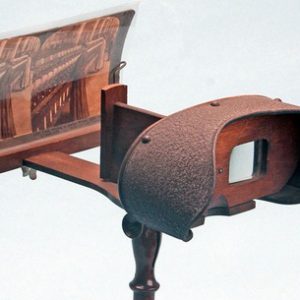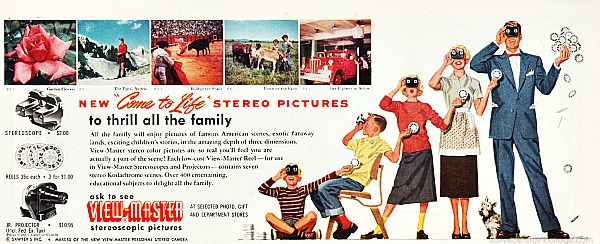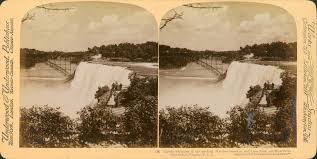My most recent dive into history started with an attempt to find the right simile to use in my novel. I wanted to describe an episode of double-vision that hits my main character. (She doesn’t yet realize that double vision is a symptom indicating she’s developed the ability to travel through time.) This is what I came up with:
It was an odd feeling, like peering through a View-Master and discovering the cardboard reel was bent and stuck between two pictures. She had owned a View-Master in her childhood and remembered those out-of-kilter images: the Statue of Liberty listing to one side, Mount Rushmore with a few extra shadowy faces superimposed on the originals.

I figured everyone would understand this comparison because everyone, at some point in time, has looked into a View-Master and marveled at a 3-D scene. So I was satisfied with my simile, but found myself curious about this toy I remembered from my childhood. I decided to learn more.
Just in case there is someone who doesn’t know about View-Masters, let’s start with the basics. A View-Master is a type of stereoscope. A stereoscope is a viewer that allows someone to look at a pair of stereo pictures and see them as a single three-dimensional image. Stereo pictures are left-eye and right-eye views—views at slightly different angles—of the same object or scene.

The first stereoscopes were invented in the early nineteenth century. Because photography was still in its infancy, these early stereoscopes showed drawings, not photographic scenes. By mid-century, things had changed—both with stereoscopes and the pictures they showed. David Brewster, a British scientist and inventor, developed a hand-held stereoscope that used lenses to merge the two pictures. And the pictures were photographs—not drawings—thus adding an additional layer of reality. Brewster exhibited his viewer in 1851 at the Great Exhibition in London. Queen Victoria became a big fan, and interest in stereoscopes spread rapidly.
In the United States, Oliver Wendell Holmes (the father of the man who would become a Supreme Court Justice) invented an inexpensive stereoscopic viewer and photographers began producing stereoscope cards of famous people, majestic natural wonders, and faraway lands. Soon companies in Europe and the United States offered thousands of stereograph “views” to the thousands of families that kept a stereoscope in the parlor for entertainment and education. During the Civil War, Mathew Brady, known as the father of photo journalism, exhibited stereo views taken at the Battle of Antietam.
Eighty-eight years after London’s Great Exhibition, the View-Master stereoscope premiered at the 1939 World’s Fair in New York City. The View-Master differed from older stereoscopes by replacing stereograph cards with round cardboard reels each holding 7 small pairs of Kodachrome color film images. The View-Master was first marketed as an educational aide, then as a way to view tourist sights.

Another transformation occurred in the 1950s when View-Master partnered with Disney and began offering reels featuring Disney characters and scenes from the newly-opened Disneyland theme park. In subsequent decades 3-D viewers would continue to find a place both on the toy shelf and in the classroom.
The View-Master, the Holmes stereoscope, and several other types of 3-D viewers are still available along with hundreds and hundreds of reels on almost any topic. Some companies offer kits to build your own stereoscope or will make reels based on your own photographs. In addition, there are many books showcasing vintage stereo images.
Of course, the real magic of stereoscopes is what happens in the brain. The stereoscope presents the two slightly different views. The brain merges them into a fascinating three-dimensional picture.





